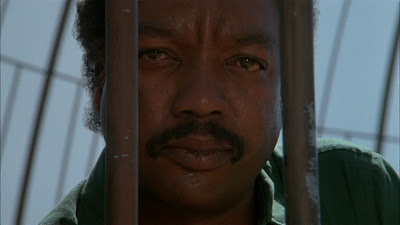 Sometimes the best art is fashioned from the simplest of elements. On its surface, White Dog comes off like a low-budget contractual obligation at the end of a career, or a career-in-transition vehicle for a rising star (Kristy McNichol) gone miserably wrong. However, and especially after its first half hour, White Dog stands as Samuel Fuller's most profound work. Unappreciated even up unto its director's passing, the long overdue DVD release of White Dog should bring more allure and discussion about Fuller's ever evolving legacy.
Sometimes the best art is fashioned from the simplest of elements. On its surface, White Dog comes off like a low-budget contractual obligation at the end of a career, or a career-in-transition vehicle for a rising star (Kristy McNichol) gone miserably wrong. However, and especially after its first half hour, White Dog stands as Samuel Fuller's most profound work. Unappreciated even up unto its director's passing, the long overdue DVD release of White Dog should bring more allure and discussion about Fuller's ever evolving legacy.Like the controversial Peeping Tom did for Michael Powell , Samuel Fuller's White Dog went a long way in (temporarily) damaging the reputation of its creator. While unfair, the shock of a Peeping Tom was understandable in the footsteps of Powell's A Canterbury Tale, I Know Where I'm Going, and The Red Shoes. But Fuller was a different case. He was the cigar-chomping bastard director of The Naked Kiss, a movie still able to shake modern sensibilities with its portrayal of bald prostitutes, molestation, and handicapped children. So why suddenly all the fuss?
Well, White Dog confronts the topic of racism, and, as we well know - perhaps now more than ever - race is an arena few artists dare to enter. The quickest way to quiet somebody (an artist) is to label them a racist. Meanwhile, representations in art over issues such as racial identity, immigration, and poverty get either glossed over or swept under the rug, leaving our culture the weaker for it.
 Late one night in the Hollywood Hills, an aspiring actress, Julie (McNichol), hits a dog with her car. She takes the all-white German Shepard to the vet then keeps watch over him while awaiting a response from her FOUND DOG fliers. After saving her from a rapist, Julie and the dog bond. However, Julie soon discovers that her new companion is an attack dog trained to maul black people. She then takes the dog to a animal shelter where a man named Keys (Paul Winfield) vows to break the mutt from its hateful ways.
Late one night in the Hollywood Hills, an aspiring actress, Julie (McNichol), hits a dog with her car. She takes the all-white German Shepard to the vet then keeps watch over him while awaiting a response from her FOUND DOG fliers. After saving her from a rapist, Julie and the dog bond. However, Julie soon discovers that her new companion is an attack dog trained to maul black people. She then takes the dog to a animal shelter where a man named Keys (Paul Winfield) vows to break the mutt from its hateful ways.The scenes between Keys and the German Shepard make up the heart of White Dog. As Keys' racial counterpart, it was an ingenious move by Fuller to bottle the learned behaviors of hatred and bigotry inside of an animal instead of a human. An actor would be too aware, handling face-to-face scenes of unleashed and uncaged racial confrontation with a heavy, knowing cloud over their head. But a dog acts on instinct; its performance doesn't pay notice to the camera.
Images of Keys lifting his shirt, exposing his black skin just inches from the caged eyes of a snarling white-coated beast are equal to the purest visual cinema we get from silent film. In fact, sequences between Keys and the dog retain their power even with the sound turned down. Keys' resilience is admirable, almost saintly. When the dog escapes and brutally kills a man inside a church (looking up at a stained-glass image of St. Francis as if to scoff at it), Keys refuses to put him down, even against the wishes of Julie. Allusions to Keys as a MLK-type figure would not be ridiculous.

Like any great film, multiple viewings and late-night reflection can open up doorways and interpretations that didn't initially stand out. One of my pet theories about White Dog is that, on a sub-textual level, the dog symbolizes Hollywood producers/"the industry", a guard keeping red-fanged watch on frustrated visionaries like Fuller.
In one specific scene (pictured above) Julie's dog tags along on a film shoot. Before the set is crashed in a fit of stark violence by the dog onto a black actress, Fuller gives us a peek of this "movie inside a movie" being filmed. Shot against cheap rear projection and flimsy props, two young women tour the streets of Paris. One can't help but see this as Fuller's jabbing acknowledgement that France became somewhat of a critical safety zone for him in his later years. And there is further, possible back-scratching reference to the New Wave's well-known validation of Fuller when Nichols takes a copy of Hitchcock/Truffaut with her to the hospital as a get well gift for the attacked actress.
On its broadest level, White Dog is about ingrained bigotry of all kinds. Learned or not, that type of behavior is inexcusable and Fuller treats it as such. However, he also appreciates the complication (see the black & white type on a gray background during the title sequence) and steps away from any quick condemnation. Why else do you think he chose a dog, perhaps the most sympathetic creature on Earth, to carry the weight of the most despicable actions of humankind?
[NOTE: Movie stills taken from DVDBeaver]




没有评论:
发表评论